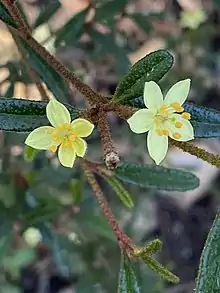| Asterolasia rivularis | |
|---|---|
 | |
| Asterolasia rivularis in the ANBG | |
| Scientific classification | |
| Kingdom: | Plantae |
| Clade: | Tracheophytes |
| Clade: | Angiosperms |
| Clade: | Eudicots |
| Clade: | Rosids |
| Order: | Sapindales |
| Family: | Rutaceae |
| Genus: | Asterolasia |
| Species: | A. rivularis |
| Binomial name | |
| Asterolasia rivularis | |
Asterolasia rivularis is a small, upright shrub, with narrow leaves and yellow flowers. It has a restricted distribution in New South Wales.
Description
Asterolasia rivularis is a small shrub to 1.5 m (4 ft 11 in) high with young branches covered in brown to grey star-shaped, short matted hairs. The leaves may be narrowly oblong, narrow-oblong to wedge shaped and tapering at the base, 1–2.5 cm (0.39–0.98 in) long, 2–3 mm (0.079–0.118 in) wide. The leaf upper surface has occasional star-shaped hairs, underside brownish star-shaped to short matted hairs, margins slightly rolled under and narrowing to a short petiole. The flowers are either borne from leaf axils or at the end of branches in small clusters of 1-3, yellow petals about 6 mm (0.24 in) long, upper surface with rusty star-shaped to short matted hairs. The pedicels are up to 3 mm (0.12 in) long when in flower. Flowering occurs in early spring.[2][3]
Taxonomy
The species was first formally described by Paul G. Wilson in 1998 and the description was published in the journal Nuytsia.[1][4]
Distribution and habitat
Asterolasia rivularis has a restricted distribution, it is found growing along streams near Buxton.[3]
References
- 1 2 "Asterolasia rivularis". Australian Plant Name Index. Retrieved 18 June 2020.
- ↑ Harden, G.J; Mole, B.J. "Asterolasia rivularis". PlantNET-Flora of New South Wales. Royal Botanic Gardens Sydney. Retrieved 15 June 2020.
- 1 2 Wilson, Paul G.; Wilson (ed), Annette (2013). Meliaceae, Rutaceae, Zygophyllaceae Volume 26. Melbourne: ABRS-CSIRO Publishing. p. 423. ISBN 9780643109568.
{{cite book}}:|last2=has generic name (help) - ↑ Wilson, Paul G. (1998). "Wilson, Paul G. (1998), Nomenclatural notes and new taxa in the genera Asterolasia, Drummondita and Microcybe (Rutaceae: Boronieae)". Nuytsia. 12 (1): 85. Retrieved 18 June 2020.